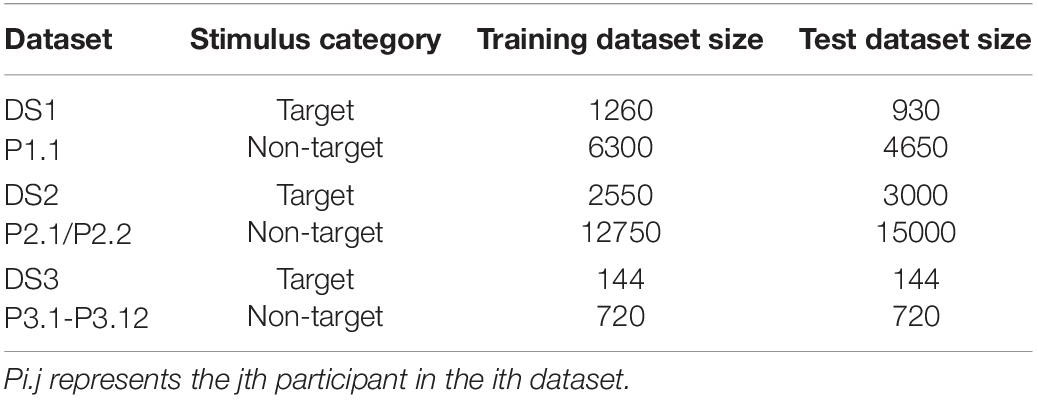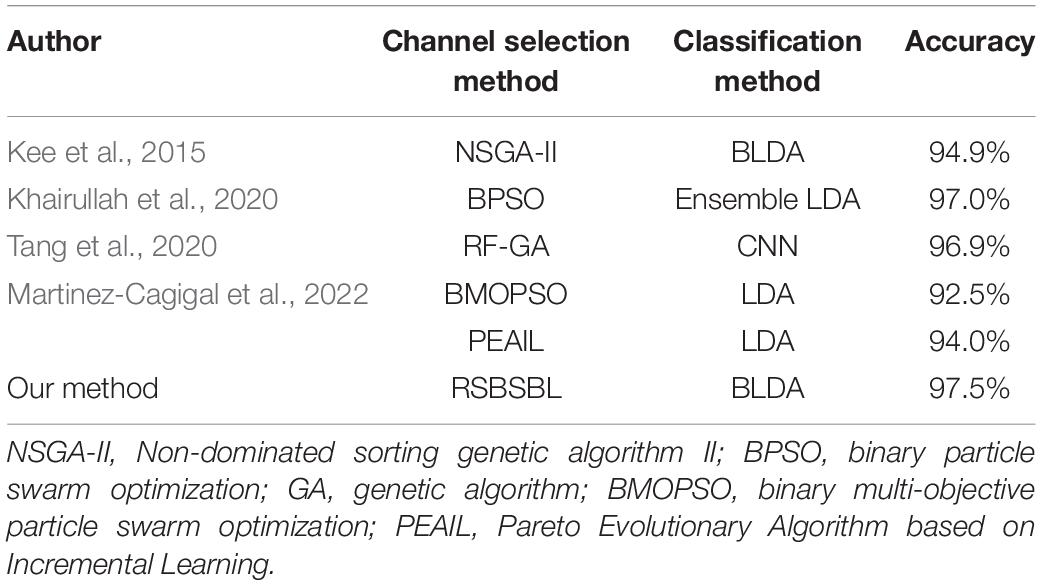- 1The Key Laboratory of Smart Manufacturing in Energy Chemical Process, Ministry of Education, East China University of Science and Technology, Shanghai, China
- 2Shenzhen Research Institute of East China University of Technology, Shenzhen, China
- 3g.tec medical engineering GmbH, Graz, Austria
- 4Skolkovo Institute of Science and Technology, Moscow, Russia
- 5Systems Research Institute of Polish Academy of Science, Warsaw, Poland
- 6Department of Informatics, Nicolaus Copernicus University, Toruń, Poland
The P300-based brain–computer interfaces (BCIs) enable participants to communicate by decoding the electroencephalography (EEG) signal. Different regions of the brain correspond to various mental activities. Therefore, removing weak task-relevant and noisy channels through channel selection is necessary when decoding a specific type of activity from EEG. It can improve the recognition accuracy and reduce the training time of the subsequent models. This study proposes a novel block sparse Bayesian-based channel selection method for the P300 speller. In this method, we introduce block sparse Bayesian learning (BSBL) into the channel selection of P300 BCI for the first time and propose a regional smoothing BSBL (RSBSBL) by combining the spatial distribution properties of EEG. The RSBSBL can determine the number of channels adaptively. To ensure practicality, we design an automatic selection iteration strategy model to reduce the time cost caused by the inverse operation of the large-size matrix. We verified the proposed method on two public P300 datasets and on our collected datasets. The experimental results show that the proposed method can remove the inferior channels and work with the classifier to obtain high-classification accuracy. Hence, RSBSBL has tremendous potential for channel selection in P300 tasks.
Introduction
Brain–computer interface (BCI) is a direct interactive pathway designed to establish a non-muscle connection between the human brain and the computer (Wolpaw et al., 2002; Jin et al., 2015). It provides a new way to communicate with the outside, for example, daily communication (Sorbello et al., 2017; He et al., 2019) and wheelchair control (Kim et al., 2016; Deng et al., 2019). In addition, BCIs can also be used to aid in the diagnosis of disorders of consciousness (Maestú et al., 2019; Ando et al., 2021). BCIs can be divided into invasive and non-invasive ones. Electroencephalography (EEG) is a non-invasive technique that records brain signals through electrodes placed on the scalp. Generally, users’ brain signals are recorded, amplified, and pre-processed with an EEG recorder, and then the signals are converted to commands via classifiers (Bashashati et al., 2007). Currently, BCIs based on the Event-Related Potential (ERP) (Hoffmann et al., 2008a; Lopez-Calderon and Luck, 2014), Steady-State Visual Evoked Potential (SSVEP) (Nakanishi et al., 2017), and Motor Imagery (MI) (Padfield et al., 2019) are the three main research directions. The oddball paradigm is a typical paradigm of P300, where standard and deviant stimuli are included. These two kinds of stimuli appear randomly with large and small probabilities, and deviant stimuli are the targets in small probability events that correspond to the spelling character (Donchin et al., 2000). The spelling paradigms and algorithms based on P300 have been widely developed in recent years (Cecotti and Graser, 2010; Townsend et al., 2010; Hammer et al., 2018; Arvaneh et al., 2019; Jin et al., 2019; Huang et al., 2022). This study is focused on the P300 BCI system.
To provide a complete coverage of regions related to EEG activity, a large number of electrodes are used for EEG acquisition. An electrode is regarded as a channel. However, a realistic EEG system typically uses the data of a small number of channels during computation to minimize the preparation time and cost (Cecotti et al., 2011). Channel selection helps to exclude the weak task-relevant and noisy channels, thus improving the classification accuracy and reducing the classifier training time. Inter-participant differences and equipment differences can make the best subset of channels in the same paradigm different. The flexibility of selecting a subset of empirical channels in the complex BCI data is insufficient, and the data-based channel selection method is more conducive to giving the optimal channel selection. Therefore, the method of automatically determining a subset of channels has better application prospects than selecting a fixed subset.
Different evaluation approaches, such as filter, wrapper, embedded, hybrid, and human-based techniques have been widely used to select features and the subset of channels in the P300 speller (Alotaiby et al., 2015). Filters like Fisher Score (Lal et al., 2004) are usually independent of the classifier and select channels based on the relevance. A CCA spatial filter also proved to be effective in event-related signal processing (Reichert et al., 2017). On the other hand, wrappers select the channel set according to the algorithm effect and search for channels through continuous heuristic methods. Support Vector Machine based recursive channel elimination (SVM-RCE) can be considered a typical example of a wrapper (Rakotomamonjy and Guigue, 2008). The hybrid approach is a combination of filter and wrapper and uses the wrapper to obtain a subset of the available channels after handling the filter (Liu and Yu, 2005). The human-based approaches are the methods in which the experienced experts select channels by analyzing certain technical indicators (Tekgul et al., 2005). In addition, some channel selection algorithms are based on evolutionary algorithms, such as Particle Swarm Optimization (PSO), which also belong to wrappers (Martinez-Cagigal and Hornero, 2017; Arican and Polat, 2019). For embedded methods, the selection is usually implicit and integrated with the learner training process. By giving sparse weight to features or channels, sparse methods can obtain a classifier that needs fewer selected features or channels. The Least Absolute Shrinkage and Selectionator operator (LASSO), a linear regressor with L1 regularization, can be regarded as an embedded method (Tibshirani, 1996). In EEG research, LASSO has also become a commonly used feature selection algorithm and extended to channel selection (Tomioka and Müller, 2010). Yuan extended the LASSO method to groups in 2006, giving birth to the group LASSO (GLASSO), which allows us to group all variables and then penalize the L2 parametrization of each group in the objective function, thus achieving the effect of eliminating a whole group of coefficients to zero at the same time (Yuan and Lin, 2006). The Bayesian framework-based feature selection and classification methods are widely used in EEG. Studies have shown the outstanding performance of Bayesian linear discriminant analysis (BLDA) in EEG decoding (Hoffmann et al., 2008a; Lei et al., 2009; Manyakov et al., 2011). Tipping et al. proposed a sparse Bayesian learning (SBL) method under the Bayesian framework to solve the regression problem (Tipping, 2001). SBL can complete the feature selection of P300 through sparsity (Hoffmann et al., 2008b) and has been used for channel selection (Wu et al., 2014; Zhang et al., 2017; Dey et al., 2020). EEG is a common response of regional neurons (Hassan and Wendling, 2018). However, the channel optimization approach described above does not consider the spatial structure between the channels of EEG signals. In addition, a few existing algorithms consider the temporal correlation in a single channel, which means the amplitude correlation between time points within each channel.
This paper proposes a regional smoothing SBL (RSBSBL) method for channel selection of the P300 signal. Block sparse Bayesian learning (BSBL) was first proposed for sparse signal recovery (Zhang and Rao, 2011). It is the first time that the BSBL is applied to EEG channel selection. The P300 features are usually filtered and down-sampled in the temporal series, and features from the same channel are correlated. In this method, we combine BSBL with the spatial distribution properties of EEG to propose an RSBSBL. To ensure practicality, we design an automatic selection iteration strategy model to reduce the time cost caused by the inverse operation of large-size matrices.
For verification, RSBSBL was compared with some other methods with similar principles on the three BCI datasets. We used BLDA as a unified classifier for a fair comparison. The effectiveness of the proposed method was verified by the effectiveness of channel subsets and the character recognition performance.
We organize the rest of the paper as follows. Section “Materials and Methods” describes the principle and calculation process of the proposed algorithm. Section “Materials and Experiments” describes the dataset used and the data processing framework. Section “Results” shows the experimental results. Section “Discussion” further discusses the effectiveness of the selected channel subsets, character recognition performance, effectiveness of regional smoothing, time cost, and future work. Finally, section “Conclusion” gives the conclusion.
Methods
Here, we show the principle and solution process of RSBSBL and give its flow of selecting channels. The input features of one channel are regarded as a block. Based on the BSBL, we considered the spatial distribution of EEG and divided different regions according to the location of the electrodes. The automatic selection mode of the iterative strategy is used to ensure practicality.
Regional Smoothing Sparse Bayesian Learning
The EEG signals collected by the device are generally two-dimensional data after pre-processing. Nc is denoted as the number of channels and Nt as temporal points. Input data X contains N samples x1,x2,x3 …… xN ∈ RD, where D = NtNc represents the number of features in each sample. Then, X = [x1,x2,x3, … xN]T ∈ RN × D and y = [y1,y2,y3, …, yN]T ∈ RN represent the corresponding labels, where yi ∈ {1,−1} is the class label. Its mathematical model can be expressed linearly as follows:
where w = [w1,w2,w3 …… wD]T is a learnable weight vector, ε is noise, and X can be replaced by Φ(X) expressed in the form of a kernel function. Assume ε ∼ 𝒩 (0, σ2IN), then y ∼ 𝒩 (Xw, σ2IN) and its probabilistic framework is.
The RSBSBL adds the symmetric positive definite matrix in the variance term of the distribution that w obeys. The input data of one channel are regarded as a block. So, for the mathematical model (1), assume that wb(∀b) is mutually independent and Gaussian distributed.
where wb containing several wi is bth block of w, γb is a non-negative scalar that controls the variance of wb, Bb is a positive definite matrix reflecting the intra-block correlation, and Nb is the number of blocks. Since the features of a channel are considered to be a block, Nb = Nc.
In our case of EEG signal, b is the index of channels. In a channel of EEG signal with corresponding weight wb, it is assumed that all its feature weights share the same γb to control the variance of their distribution, and Bb controls the intra-block correlation.
In this case, we express the prior of w as p(w|γ, B) ∼ 𝒩 (0, Σ0), where Σ0 is
the posterior probability has been calculated by the Bayesian rule,
and the corresponding variance and mean of the posterior probability density p(w|y, σ2, γ, B) ∼ 𝒩 (μw, Σw) can be described as
When N ≥ D, the Eqs (6) and (7) are suitable because the maximum size of the inverse matrix is D in this case. Now, we give the iterative ways when N < D. According to the matrix inversion formula and the matrix identity.
we replace the Eqs (6) and (7) with the following equations:
To find the iterative equation of the parameters Θ = {γ, B, σ2}, the expectation–maximization (EM) is used to maximize log p (y|Θ). The Q function is.
The first term of the Q function is related to σ2 and the second term is related to γ and B. Then, we can get the parameters iteratively by maximizing the Q function.
where *old represents the hyperparameter in the previous iteration, and the superscript b of and indicates the bth block in μw and Σw with the size of db × 1 and db × db (db is the number of elements in wb).
The potential similarity exists in the adjacent electrode signals considering the volume conduction effects in the brain (Hassan and Wendling, 2018). We assign the same Bre for channels with close locations for regional smoothing, and the region Gre contains gre channels. As shown in Figure 1, all the channels are divided into 13 regions by position, and each region contains at least three channels. Bre is the average of blocks in region re (re ∈ [1, 13]).
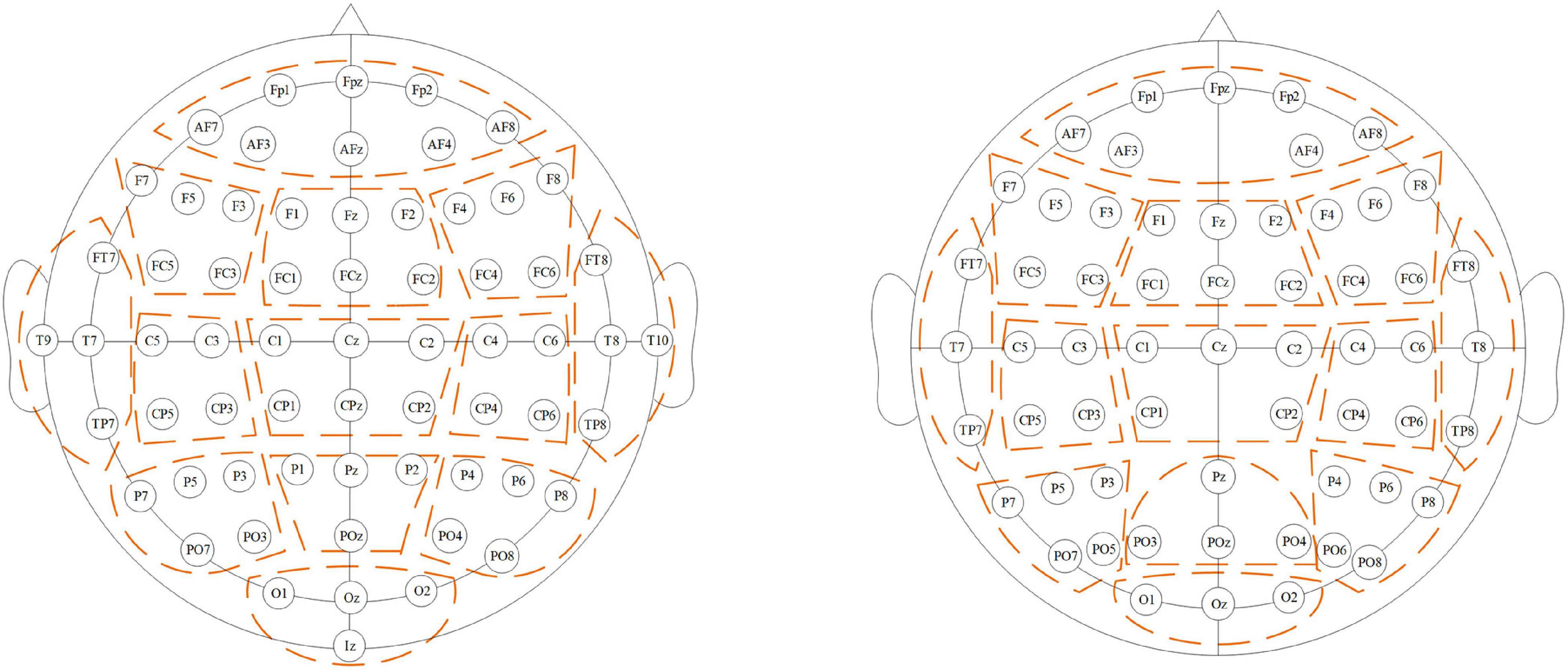
Figure 1. Region division. Channels belonging to a region are circled with the dotted line. The left subfigure shows the division for DS1 and DS2, while the right subfigure shows the division for DS3.
We use a first-order Auto-Regressive (AR) process to model the intra-block correlation. Many applications have used the AR process to express it (Zhang and Rao, 2011; Zhang et al., 2013; Yin et al., 2020). Thus, to find a symmetric positive definite matrix to approximate B, it can be constrained to the following form of the Toeplitz matrix.
Empirically calculate , where m0 is the average of the main diagonal of Bre and m1 is the average of the main sub-diagonal.
Channel Selection Based on Regional Smoothing BSBL
Regarding the feature extracted from the same channel as a block, we perform RSBSBL to get the weight vector of features and design a channel selection based on the weight vector as Algorithm 1.
Algorithm 1: Regional Smoothing Sparse Bayesian Learning (RSBSBL).
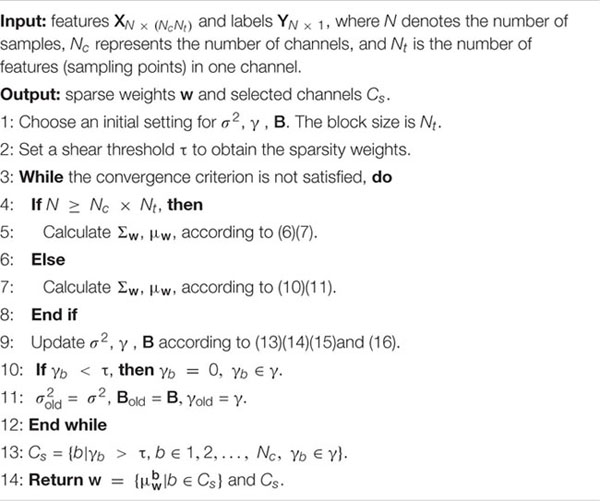
As shown in Algorithm 1, the parameters are initialized, and the shear threshold τ is set. Then, from Line 3 to Line 12, the algorithm iteratively solves BSBL and prunes the γ. Line 4 to Line 8 decide the calculation of Σw, μw, so that the large time cost caused by finding the inverse matrix of a large-size matrix can be alleviated. The parameters are updated on Line 9 and Line 10. Figure 2 illustrates the relationship between the parameters in a single iteration, where the parameters calculated simultaneously have the same color. The solid line indicates the passing relationship between the parameters of this iteration, and the dashed line indicates the passing relationship between the parameters of this iteration and the next iteration. After the parameters are calculated, in order to achieve the sparse block effect, make γb to 0 when γb is less than the threshold τ. Then, it comes into the next iteration until the convergence criterion is satisfied. Line 13 automatically selects the channels with γb greater than the shear threshold τ. Finally, the algorithm returns the selected channel and the corresponding weight vector.
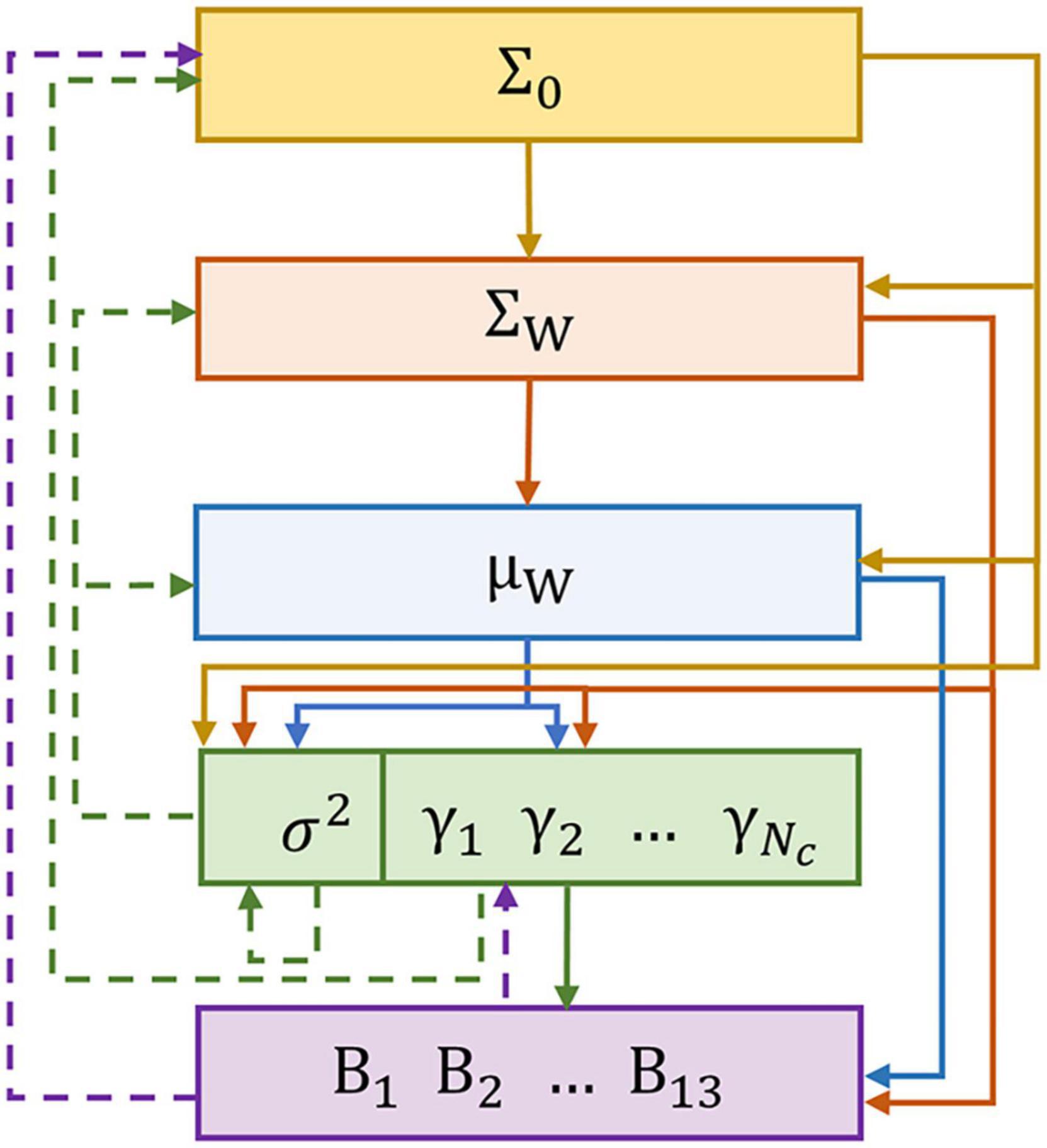
Figure 2. Parameter relationship graphical model in a single iteration. Parameters of the same color can be iterated simultaneously.
The off-diagonal matrix B makes the weights w in the same block relevant in distribution. It means that the correlation of the features from the same channel can be reflected during the process. Moreover, the components of the temporal correlation of different channels in close locations are the same because the Bre of channels in the same region are shared. The sparsity of weights will form the units of channels. The features from one channel share the same weight distribution whose variance is controlled by γ. For practicality, up to five channels are removed in a single iteration when making a channel selection.
Materials and Experiments
Data Descriptions
Three datasets were used in this study to validate the proposed method. DS1 is BCI Competition II dataset IIb (one participant) (Blankertz et al., 2004) and DS2 is BCI Competition III dataset II (two participants) (Blankertz et al., 2006). DS3 is the EEG signal collected in our lab (12 participants). The stimulus numbers for each participant of the above three datasets are shown in Table 1.
DS1 and DS2 provided by the BCI Competition are public datasets and follow the same experimental paradigm of Farwell and Donchin, as shown in Figure 3. In a six-by-six character matrix containing 26 characters and 10 numbers, participants were asked to focus on a specified character in each trial (a trial is a set of stimuli that can support the output of a recognized character). They could do this by mentally counting the target stimuli’ number of flashes (intensifications). The paradigm continuously intensified and randomly scanned all rows and columns of the matrix at a rate of 5.7 Hz. Each row and column in the matrix was randomly intensified for 100 ms and was left blank for 75 ms. DS1 contained 42 training characters and 31 testing characters. The training set of DS2 contained 85 characters, and the testing set contained 100 characters. A trial for each character had 15 epochs to apply reliable spelling, and each epoch was comprised of 12 intensifications. Both datasets were collected using a 64-channel cap, filtered by 0.1–60 Hz, and digitized at a sampling rate of 240 Hz. DS1 and DS2 can be downloaded from the websites: http://www.bbci.de/competition/ii/ and http://www.bbci.de/competition/iii/.
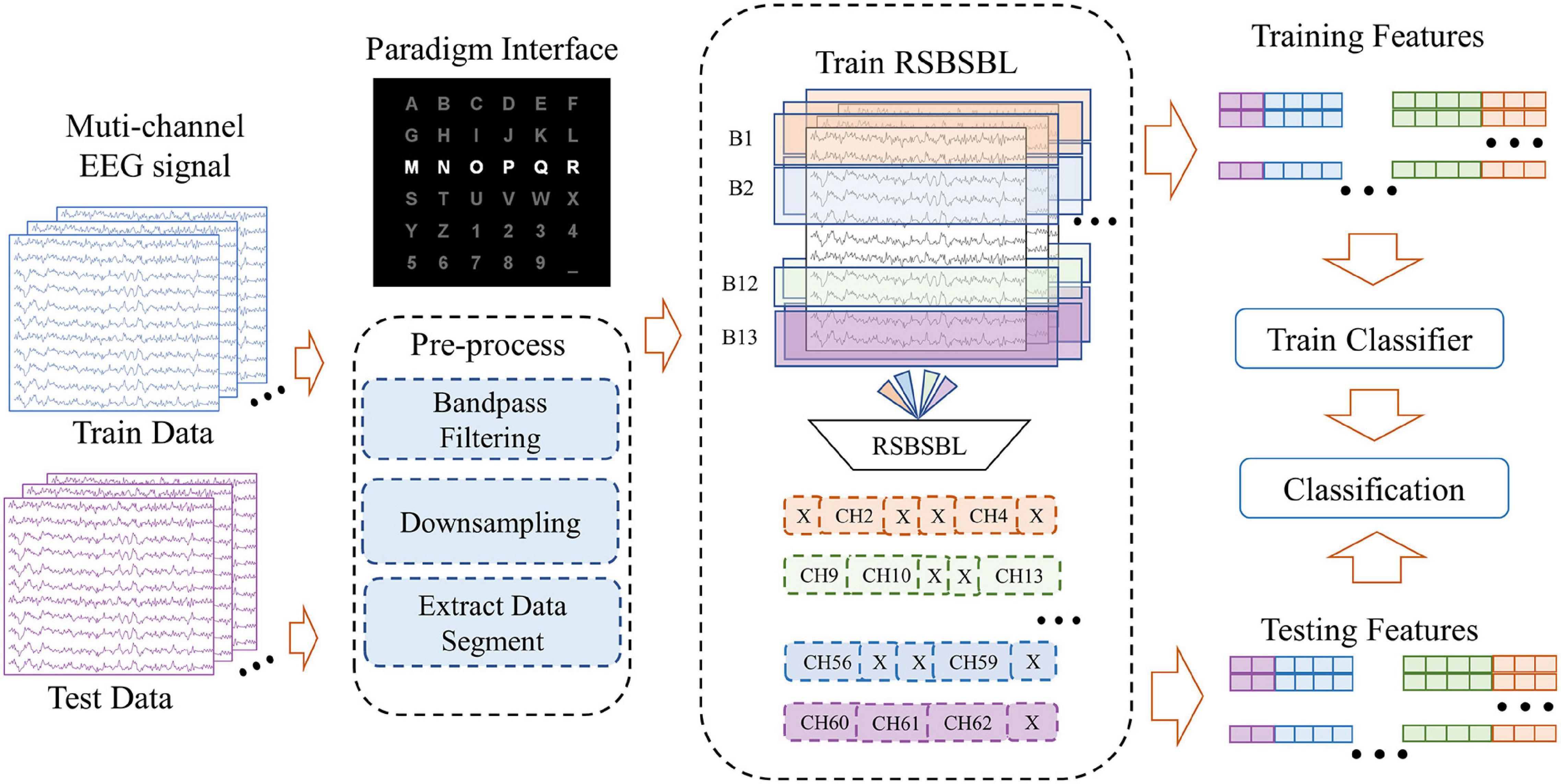
Figure 3. Diagram of the data processing framework, including pre-processing, channel selection, and classification. Using the block sparsity property of RSBSBL, we do pruning on the eligible channels by fitting the training data and labels.
DS3 was collected in our lab. Its paradigm was similar to the BCI Competition. It contained 26 characters and 10 numbers. DS3 consisted of 12 participants who were graduate students between the ages of 20 and 26 years, with normal or corrected-to-normal vision. The experiments used a 64-channel wireless EEG acquisition system (Neuracle, NeuSen W series, 59 EEG, 4EOG, 1ECG) to acquire data at the sampling rate of 1,000 Hz. In the paradigm, each row and column in the six-by-six matrix was randomly intensified for 80 ms and kept extinguished for 80 ms. A trial for each target character included four epochs, and each epoch had 12 intensifications. Participants were required to spell 36 characters. We randomly selected 18 characters as the training dataset and the rest as the test dataset.
The Framework of Data Processing
Considering that some channels contain less task-relevant information but more noise, it is vital to use a reasonable method to select the most effective channels. This study compares the proposed RSBSBL with two empirical channel sets (Set 1 and Set 2) (Krusienski et al., 2008), LASSO, GLASSO, and SBL in the case of using the same pre-processing process and classifier. Set 1 includes Fz, Cz, Pz, Oz, PO7, and PO8. Set 2 includes Fz, FCz, Cz, C3, C4, CPz, Pz, P3, P4, P7, P8, POz, PO3, PO4, PO7, PO8, Oz, O1, and O2.
Figure 3 shows the diagram of the data processing framework, which includes three main parts: (1) pre-processing, (2) channel selection, and (3) classification. DS1 and DS2 shared the same pre-processing: bandpass filtering of data from 0.5 to 20 Hz and downsampling by a factor of 5. Then, the sampling rate of the data was 48 Hz. We intercepted 0–667 ms after each stimulus as the primary analysis objective was to obtain 32 sampling points for each stimulus. For the DS3, the 59-channel dataset that went through 0.5–20 Hz bandpass filtering was down-sampled to 50 Hz and the data segment from 0 to 600 ms was taken after stimulation to obtain 30 sampling points for each stimulus. Thus, denoting the number of channels as Nc and number of signal sampling points as Nt, a 1 × D feature matrix was obtained for each stimulus, where D = NtNc. A feature matrix was labeled “1” only if the corresponding stimulus belongs to the row or column of the target characters. Otherwise, the label was assigned to “0.”
The typical classification methods of P300 include traditional machine learning methods and neural network-based methods. Traditional machine learning can achieve outstanding performance with less complexity. This study regarded BLDA as a unified classifier for different channel selection algorithms.
Parameter Setting
The optimal combination of parameters was determined by a 10-fold cross-validation. There were two modes of the selected channel number in the experiment for the channel selections: automatic and fixed. When the channel number was determined automatically, we used a threshold to determine the channel number. For LASSO and SBL, the absolute values of the feature weights in one channel were summed up to represent the importance of the channel. The threshold equaled the mean minus 0.5 times the standard deviation of the channel importance values, and the channels with importance values higher than the threshold were selected. As for GLASSO and RSBSBL, automatic channel selection had been enabled in the methods. When the number of selected channels is fixed (M channels were selected), we used the same way to evaluate each channel. For all the four methods, the absolute values of the feature weights w of each channel were summed, and the top M channels were selected in descending order.
Evaluation
We used character recognition accuracy to evaluate the performance of a classification. The character recognition accuracy is defined as follows:
where Ctest_total represents the total number of characters in the test dataset, and Ctest_correct is the sum of all the correctly predicted characters. Besides, to evaluate the significance of performance difference, we introduced a non-parametric statistical hypothesis test, the Wilcoxon signed-rank test. The Wilcoxon signed-rank test can be used as an alternative to the paired t-test for matched pairs when the population cannot be assumed to be normally distributed. The significance of the pairs can be confirmed when the corresponding p-value is less than 0.05.
Results
We evaluated the performance of the proposed method on the three datasets. The results covered the experiments of automatic channel selection and the experiments of selecting M channels. For further analysis, we also evaluated the sensitivity of the parameters of the proposed method.
Results of Automatic Channel Selection
Channel selection is supposed to reserve channels with more helpful information and exclude the channels with more noise. According to the data processing, we chose a unified classifier to verify the performance of different methods for a fair comparison. In Table 2, we compared the character recognition accuracy of each method on the three datasets, and the number of selected channels was automatically determined as described in section “Parameter Setting.” Set 1 and Set 2 are empirical subsets of channels (Set 1 contains 6 channels and Set 2 contains 19 channels). The best results were marked in bold, and the number of channels selected for each participant is presented in the corresponding parentheses.
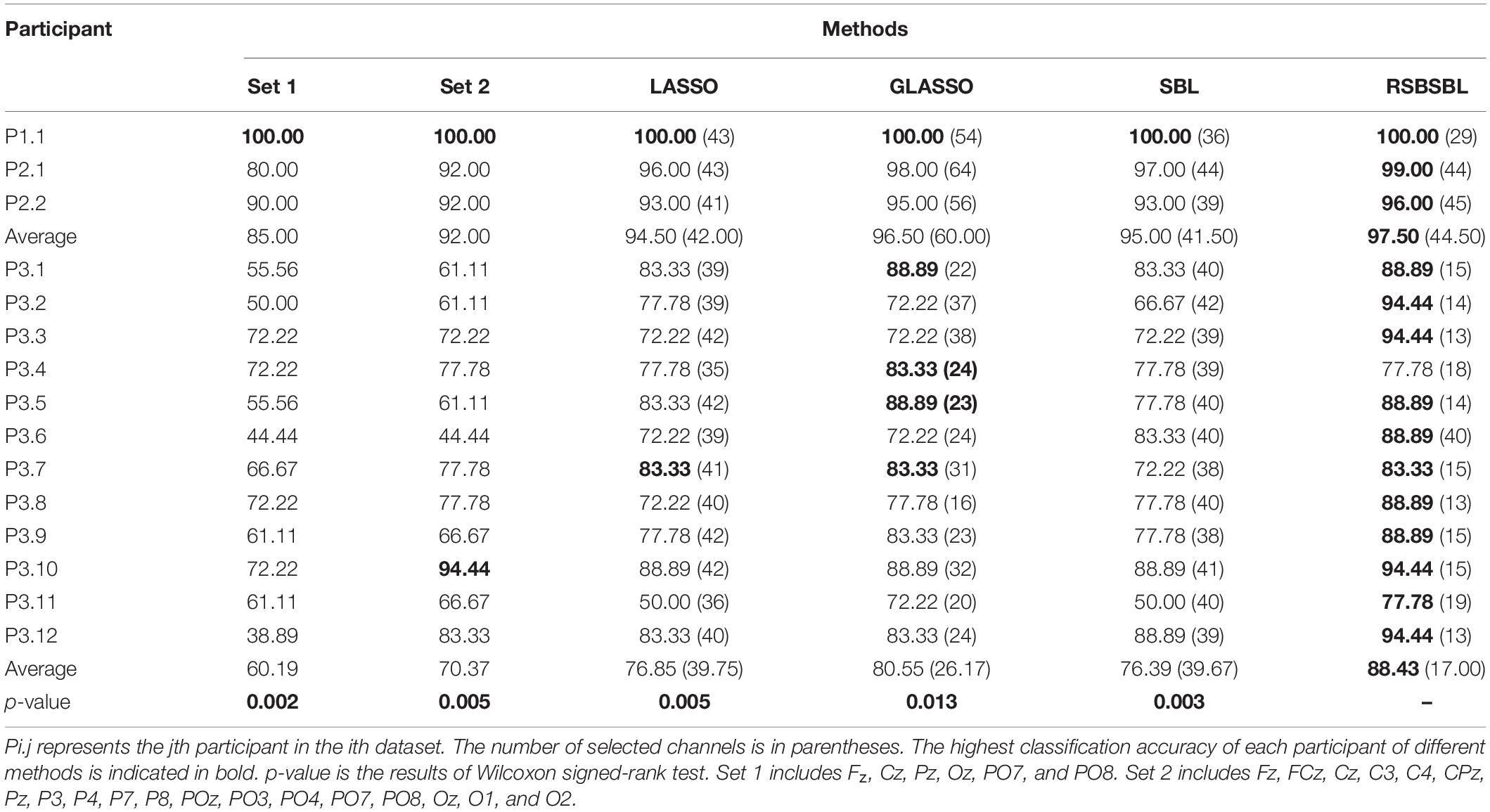
Table 2. Character recognition accuracy (%) (number of channels) and Wilcoxon signed-rank test comparisons for DS1, DS2, and DS3 when each compared method was used for channel selection.
For DS1, RSBSBL selected the minimum number of channels when the classification accuracy of all the methods was 100%. For DS2, RSBSBL had the highest average accuracy, 97.50%, which was 1.00% higher than the second-ranked GLASSO. Although SBL selected fewer channels than others, the average recognition accuracy was 95.00%.
For DS3, RSBSBL as a channel selection method could bring higher accuracy with BLDA in 11 participants among 12 and got 88.43% average accuracy by eliminating insufficient data than using all channels. It outperformed the second-ranked GSBL on an average by 7.88% and selected the fewest channels as 17. We evaluated the significance of the classification performance of DS3 via the Wilcoxon signed-rank test and found that the proposed method performed significantly better than others (RSBSBL vs. LASSO: p = 0.005 < 0.05; RSBSBL vs. GLASSO: p = 0.013 < 0.05; RSBSBL vs. SBL: p = 0.003 < 0.05).
Results of Selecting M Channels
To further compare the effectiveness of the four methods, we compared the recognition results of the algorithms when M channels were selected (M = [4, 8, 12, 16]). Top M channels were selected by ranking the corresponding channels according to the sum of the absolute values of the feature weights. The classifiers were retrained with the data with the selected channel. It was supposed that the number of channels M′ automatically selected by the method was less than the value of M. In that case, the latest deleted M-M′ channels are added according to the order in which they were deleted during the iteration of the method.
Figure 4 shows the accuracy of each method on DS1, DS2, and DS3, with the horizontal coordinates of the bars indicating the selection of the top M channels. For DS1, the accuracy of all the methods was the same except that the accuracy of SBL was 96.77% when eight channels were selected, and it was lower than others. For DS2, SBL and RSBSBL obtained better performance with 80% average recognition accuracy when four channels were selected. When 8, 12, and 16 channels were selected, GLASSO obtained an average recognition accuracy of 78.5, 84.5, 91, and 92%, respectively, and RSBSBL obtained a better performance of 80, 85.5, 91.5, and 93.5%, respectively. For DS3, GLASSO obtained average recognition accuracy of 73.61, 75.93, 75.46, and 79.63% when 4, 8, 12, and 16 channels were selected, respectively. Moreover, RSBSBL obtained the best performance of 74.07, 82.87, 80.09, and 80.56%, respectively. The average recognition accuracies of LASSO, GLASSO, and RSBSBL on DS3 with M = 16 were 77.31, 79.63, and 80.56%, respectively. The results of experiments with the fixed number of selected channels revealed that the feature weights generated by RSBSBL could provide more reasonable guidelines for the channel selection.

Figure 4. The average recognition accuracy of the four methods on DS1, DS2, and DS3 when M channels are selected, where M = [4, 8, 12, 16]. The error bars are the standard deviations for DS2 and DS3.
We counted the selected channels at the same location and used it to describe the number of times a channel has been selected in the dataset. If 6 of the 12 participants’ selected channels contain Pz, then the contribution value of the channel corresponding to the Pz electrode is 6. Figure 5 indicates the scalp distributions of the contribution value of channels on DS1, DS2, and DS3. The color changes from red to blue, indicating that the channel was selected less often. As shown in Figure 5, when the number of selected channels was small (M = 4, 8), RSBSBL selected the occipital and parietal electrodes more often. It shows that, in addition to the P300 potential, the early visual components also contribute to a classification in the paradigm (Blankertz et al., 2011).
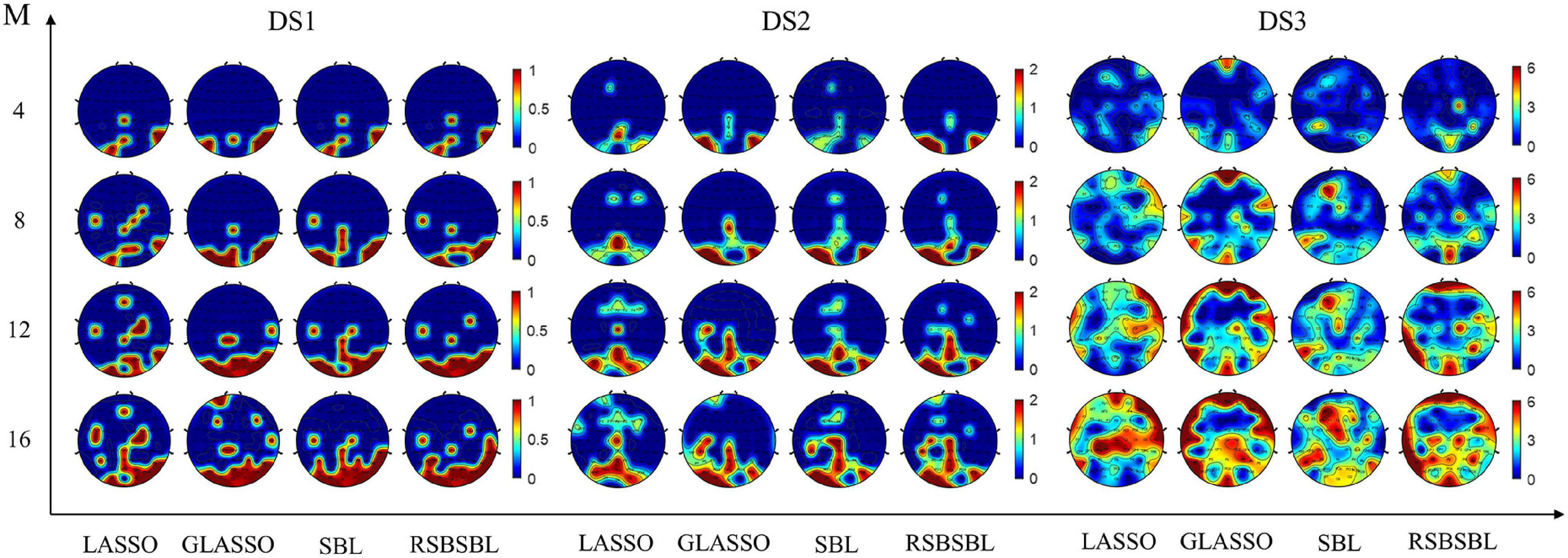
Figure 5. The scalp distribution of the four methods on DS1, DS2, and DS3 when M channels are selected. The contribution value of each channel is equal to the sum of the selected numbers among all participants in the dataset. The color changes from red to blue, indicating that the channel is selected less often.
Parameter Sensitivity
In RSBSBL, γb smaller than the threshold τ was set to zero, indicating that τ determines the pruning strength. We analyzed the change in the number of channels selected and the recognition results when τ is assigned different values in the range 10−8 to 10−1. The recognition accuracy of each participant varying with τ was normalized to highlight the location of the optimal threshold. Figure 6 illustrates the effect of the threshold on the proposed method. The x-axis indicates the number of selected channels, the y-axis indicates the value of τ, and the z-axis indicates the participant ID. The color changes from red to blue, indicating that the point corresponds to a higher to lower normalized accuracy.
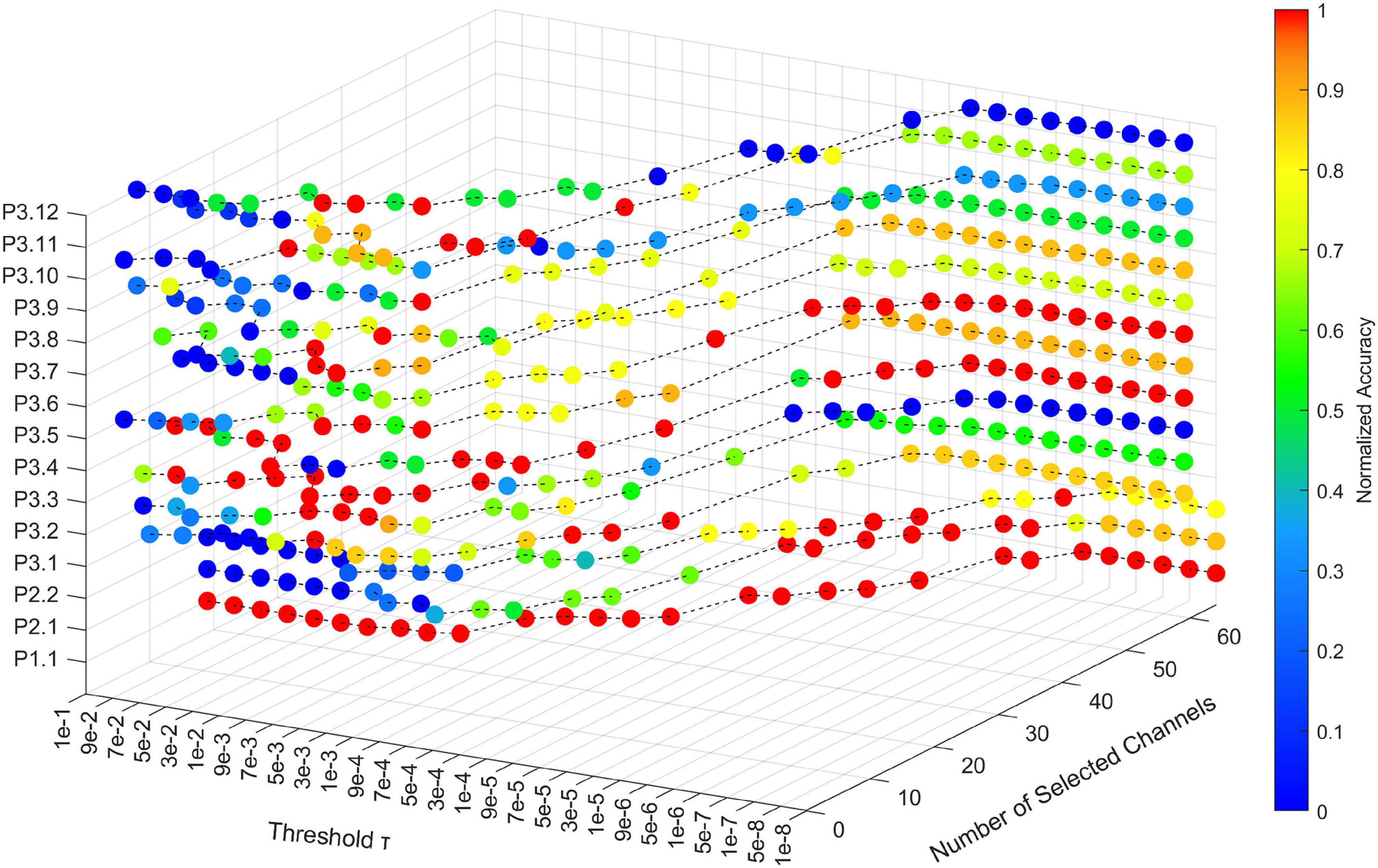
Figure 6. The effect of shear threshold τ in RSBSBL on the number of selected channels and accuracy. The x-axis indicates the number of selected channels, the y-axis indicates the value of τ, and the z-axis indicates the participant ID. The color of the sphere represents the normalized recognition accuracy for each participant with different thresholds.
As shown in Figure 6, the number of channels selected by each participant increased as the threshold value decreased. When the threshold was less than or equal to 10−6, the number of selected channels was the original number in the dataset, and the algorithm loses the ability to select the channels automatically. Therefore, 10-fold cross-validation can be used to select the optimal parameter values in the range of 10−6 to 10−1. From the curves corresponding to P3.2, P3.3, P3.7, and P3.12, using selected channels can obtain better recognition accuracy than using all the channels, which proves that channel selection can remove weak task-relevant and noisy channels to improve the classification accuracy.
Discussion
The experimental results on the three datasets illustrated that the proposed RSBSBL as a channel selection algorithm could automatically screen out effective channels and get the best overall performance among all the compared methods.
Effectiveness of Channel Subsets
Fabiani et al. (1987) confirmed that the visual P300 paradigm should at least include Fz, Cz, Pz electrodes signed as the 10–20 international electrode system. Krusienski et al. (2008) and McCann et al. (2015) made sure that Fz, Cz, Pz, Oz, PO7, and PO8 corresponded to the parietal and occipital regions of the brain that take a significant part in the recognition of P300 signals. In Table 2, Set 1 and Set 2 represent two empirical channel subsets. Set 1 includes Fz, Cz, Pz, Oz, PO7, and PO8. Set 2 includes Fz, FCz, Cz, C3, C4, CPz, Pz, P3, P4, P7, P8, POz, PO3, PO4, PO7, PO8, Oz, O1, and O2. It can be seen that for many participants (P2.1, P2.2, P3.1, P3.2, P3.5, P3.6), the character recognition accuracy was lower when the empirical channel subsets were used. The empirical selection may not include some channels that contribute to the classification. The channels assumed to reflect visual components and also some frontal channels contribute to the classification for some participants. It also indicates the lower robustness of the empirical channel subset. In Figure 5, the scalp mapped according to channel selection of RSBSBL could be observed with high values in Pz, P3, P4, O1, O2, Oz, PO7, PO8, and POz regions. These electrodes are very similar to the abovementioned electrodes, which are closely related to the visually induced ERPs. The P1, N1, and N2 components are mainly concentrated in the parietal and occipital regions. And the central distribution of P2 and P3 is elongated along the midline electrodes (Blankertz et al., 2011). It can be assumed that a multitude of ERP components is affected by attention to the target and utilized by classifiers rather than just the P300 (Treder and Blankertz, 2010). In addition, it can be found from Figures 5, 6 that many participants in DS3 had poorer classification using full-channel data compared to DS1 and DS2, and their topographic maps select more frontal channels when M = 8, 12,16. This phenomenon may be due to the effect of eye artifacts and noise during the experiment.
Character Recognition Performance
Table 2 and Figure 3 show the superiority of RSBSBL in channel selection. When the number of channels was determined automatically, the proposed method achieved the highest average recognition accuracy of 100, 97.5, and 88.43% for DS1, DS2, and DS3, with the lowest average number of channels on DS1 and DS3. The RSBSBL achieved better performance than the compared methods when selecting the channels with the fixed number, and the average accuracies of 90.21, 80, and 74.07% were obtained with the top four selected channels on the three datasets.
To verify the performance of RSBSBL, we compared the proposed method with the state-of-the-art developments in recent years on DS2, as shown in Table 3. Most of them are based on evolutionary computational algorithms (Kee et al., 2015; Khairullah et al., 2020; Tang et al., 2020; Martinez-Cagigal et al., 2022). The channel selection methods and classifiers used in each study are shown in the table.
The shear threshold τ significantly impacted the final results, so cross-validation was required to determine the optimal parameters. According to the analysis of parameter sensitivity, as shown in Figure 6, the recommended threshold selection range was [10−6, 10−1]. Besides, Figure 6 reflects the variation of character recognition accuracy with the shear threshold for each participant. Compared with others, P3.2, P3.3, P3.9, P3.10, and P3.12 cannot achieve the best recognition accuracies with the full channels, which implies that the EEG signals of these participants have more channels with noise, and these channels are not conducive to signal classification. As shown in Table 2, when determining the number of channels automatically, RSBSBL can achieve the best recognition accuracies of them with the corresponding number of selected channels of 14, 13, 15, 15, and 13, respectively. It confirms that RSBSBL can remove unfavorable channels and improve the recognition accuracies.
Effectiveness of Regional Smoothing
To verify the effectiveness of regional smoothing, we conducted further controlled experiments on the three datasets, and the results are shown in Table 4. Case 1 represents that B is a unit matrix, implying that no temporal correlation is considered. Case 2 has the same B for all blocks, indicating that all channels share the same B. Case 3 has a different B matrix for each block, showing that regional smoothing is no longer done. The comparison between Case 3 and Case 1 in Table 4 illustrates the improvement of the model due to temporal correlation. The comparison between our algorithm and Cases 3 and 1 indicates the improvement brought by region smoothing. The“*” in Table 4 represents a significant difference in our method after Wilcoxon signed-rank test (RSBSBL vs. Case 1: p = 0.015 < 0.05; RSBSBL vs. Case 2: p = 0.031 < 0.05; RSBSBL vs. Case 3: p = 0.124).
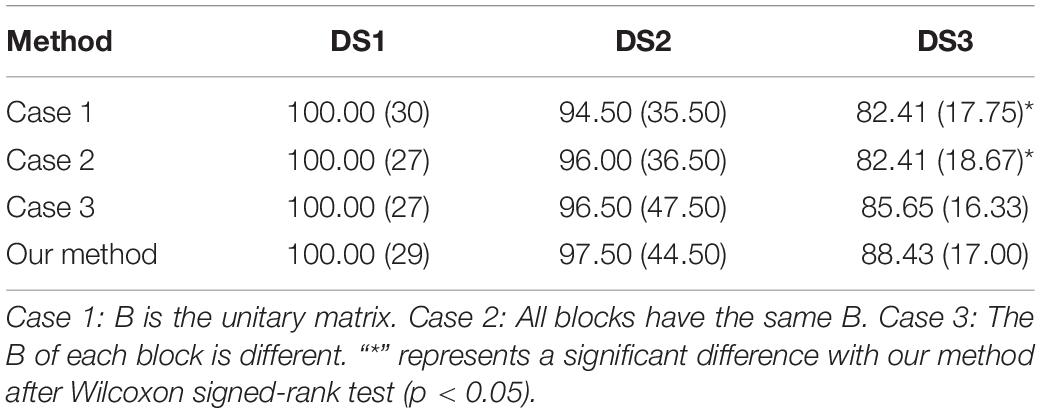
Table 4. The average character recognition accuracy (%) (number of channels) comparisons on three datasets.
Time Costs and Limitations
As described in sections “Data Descriptions” and “The Framework of Data Processing,” for DS1 and DS2, Nt = 32 and Nc = 64 after pre-processing, then we can get a 1 × D (D = NtNc = 2048) vector for each stimulus. As shown in Table 1, in the training datasets of DS1 and DS2, the total number of stimuli was 7,560 and 15,300, which is larger than the number of features D. For DS3, Nt = 30 and Nc = 59 after pre-processing, then the feature is a 1 × D (D = NtNc = 1770) vector. In Table 1, in the training datasets of DS3, the total number of stimuli was 864, which is smaller than the number of its features.
In a preliminary study, we found that inappropriate iterations can make the algorithm to have a large time cost [e.g., using equations (10) and (11) on DS1 and DS2]. Therefore, a strategy of automatic selection of the iteration method is used to avoid this problem. In Figure 7, we analyze the variation of the matrix inversion run-time when the size of the matrix increases (the matrix is a square matrix). In the left part, the horizontal axis represents the size of the square matrix. The vertical axis is the value after taking the logarithm of the time, and the actual time (s) is also indicated in the figure. It can be noticed that the time spent on matrix inversion is more than 1 s when the matrix size is larger than 3,000 × 3,000. Therefore, we consider that the method may not be suitable for data with numbers of features and samples larger than 3,000. Of course, this problem can be solved by reducing the number of features and optimizing the iteration steps. The right bar in Figure 7 indicates the average time cost of the proposed method on the three data sets, which is acceptable.
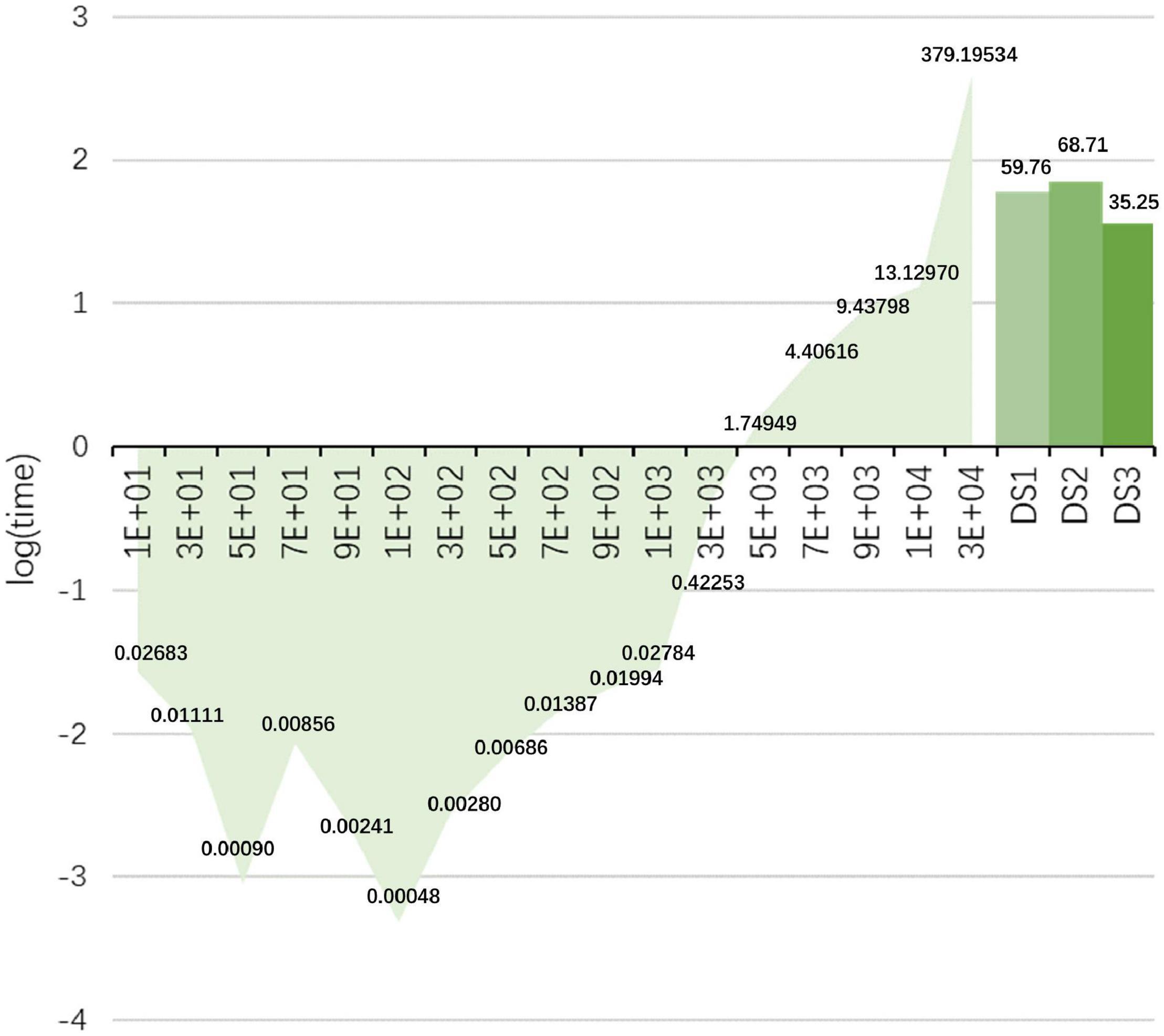
Figure 7. Changes in the run-time (s) of matrix inversion when the size of the matrix increases. In the left part, the horizontal axis represents the size of the square array. The vertical axis is the value after taking the logarithm of the time. The bar chart represents the average time cost of the proposed method on the three datasets.
Future Work
The sparse Bayesian algorithm can make the sparsity of the algorithm change by changing the prior distribution of w (Tipping, 2001). Zhang et al. (2015) used the Laplace distribution instead of the traditional Gaussian distribution for the classification of P300 signals using SBL. Therefore, RSBSBL can change the prior of the weights to make the sparsity stronger in the future, such as the Gamma distribution. The proposed method used the EM algorithm for iteration, and there is still room for improvement in the computational speed. In the future, we will also explore the suitability of the proposed method for other ERPs.
Conclusion
This study proposed a novel channel selection method, namely RSBSBL, which improved the original BSBL and obtained the assigned sparse weights. While considering the temporal correlation of sampling points of the same channel, it exploits the spatial distribution characteristics of the electrodes so that channels in adjacent regions share a positive definite matrix to get regional smoothing. Also, we discussed the efficiency of RSBSBL in the channel selection and design an automatic selection iteration strategy model to reduce the time cost caused by the inverse operation of the large-size matrix. The experimental results on three datasets indicate that RSBSBL can select appropriate channels, leading to high recognition accuracy. We will conduct future studies to improve the robustness of this algorithm.
Data Availability Statement
The original contributions presented in the study are included in the article/supplementary material, further inquiries can be directed to the corresponding author.
Ethics Statement
The studies involving human participants were reviewed and approved by the Ethics Committee of East China University of Science and Technology. The patients/participants provided their written informed consent to participate in this study. Written informed consent was obtained from the individual(s) for the publication of any potentially identifiable images or data included in this article.
Author Contributions
XZ was the main author to raise the idea of the manuscript, designed the experimental procedure, and collected the original dataset. JJ made effective suggestions on the manuscript’s structure and provided the experimental site. RX has embellished the language of the manuscript and made key suggestions. SL and HS were involved in revising the manuscript’s results section. XW and AC provided inputs for optimizing the data processing flow. All authors contributed to the manuscript revision, and read and approved the submitted version.
Funding
This work was supported by the Science and Technology Innovation 2030 Major Projects 2022ZD0208900 and the Grant National Natural Science Foundation of China under Grant 62176090; in part by Shanghai Municipal Science and Technology Major Project under Grant 2021SHZDZX; in part by the Program of Introducing Talents of Discipline to Universities through the 111 Project under Grant B17017; in part by the Shu Guang Project supported by the Shanghai Municipal Education Commission and the Shanghai Education Development Foundation under Grant 19SG25; in part by the Ministry of Education and Science of the Russian Federation under Grant 14.756.31.0001, and in part by the Polish National Science Center under Grant UMO-2016/20/W/NZ4/00354.
Conflict of Interest
RX is employed by the company g.tec medical engineering GmbH.
The remaining authors declare that the research was conducted in the absence of any commercial or financial relationships that could be construed as a potential conflict of interest.
Publisher’s Note
All claims expressed in this article are solely those of the authors and do not necessarily represent those of their affiliated organizations, or those of the publisher, the editors and the reviewers. Any product that may be evaluated in this article, or claim that may be made by its manufacturer, is not guaranteed or endorsed by the publisher.
References
Alotaiby, T., Abd El-Samie, F. E., Alshebeili, S. A., and Ahmad, I. (2015). A review of channel selection algorithms for EEG signal processing. EURASIP J. Adv. Signal Process 2015, 1–21.
Ando, M., Nobukawa, S., Kikuchi, M., and Takahashi, T. (2021). Identification of Electroencephalogram Signals in Alzheimer’s Disease by Multifractal and Multiscale Entropy Analysis. Front. Neurosci. 15:667614. doi: 10.3389/fnins.2021.667614
Arican, M., and Polat, K. (2019). ““Comparison of the Performances of Selected EEG Electrodes with Optimization Algorithms in P300 Based Speller Systems,”,” in in 2019 Scientific Meeting on Electrical-Electronics & Biomedical Engineering and Computer Science (EBBT), (Piscataway: IEEE), 1–4.
Arvaneh, M., Robertson, I. H., and Ward, T. E. (2019). A p300-based brain-computer interface for improving attention. Front. Hum. Neurosci. 12:524. doi: 10.3389/fnhum.2018.00524
Bashashati, A., Fatourechi, M., Ward, R. K., and Birch, G. E. (2007). A survey of signal processing algorithms in brain-computer interfaces based on electrical brain signals. J. Neural Eng. 4:R32. doi: 10.1088/1741-2560/4/2/R03
Blankertz, B., Lemm, S., Treder, M., Haufe, S., and Müller, K.-R. (2011). Single-trial analysis and classification of ERP components—a tutorial. Neuroimage 56, 814–825. doi: 10.1016/j.neuroimage.2010.06.048
Blankertz, B., Muller, K.-R., Curio, G., Vaughan, T. M., Schalk, G., Wolpaw, J. R., et al. (2004). The BCI competition 2003: progress and perspectives in detection and discrimination of EEG single trials. IEEE Trans. Biomed. Eng. 51, 1044–1051. doi: 10.1109/TBME.2004.826692
Blankertz, B., Muller, K.-R., Krusienski, D. J., Schalk, G., Wolpaw, J. R., Schlogl, A., et al. (2006). The BCI competition III: validating alternative approaches to actual BCI problems. IEEE Trans. Neural Syst. Rehabil. Eng. 14, 153–159. doi: 10.1109/TNSRE.2006.875642
Cecotti, H., and Graser, A. (2010). Convolutional neural networks for P300 detection with application to brain-computer interfaces. IEEE Transac. Pattern Anal. Mach. Intell. 33, 433–445. doi: 10.1109/TPAMI.2010.125
Cecotti, H., Rivet, B., Congedo, M., Jutten, C., Bertrand, O., Maby, E., et al. (2011). A robust sensor-selection method for P300 brain-computer interfaces. J. Neural Eng. 8:16001. doi: 10.1088/1741-2560/8/1/016001
Deng, X., Yu, Z. L., Lin, C., Gu, Z., and Li, Y. (2019). A bayesian shared control approach for wheelchair robot with brain machine interface. IEEE Trans. Neural Syst. Rehabil. Eng. 28, 328–338. doi: 10.1109/TNSRE.2019.2958076
Dey, M. R., Shiraz, A., Sharif, S., Lota, J., and Demosthenous, A. (2020). Dictionary selection for compressed sensing of EEG signals using sparse binary matrix and spatiotemporal sparse Bayesian learning. Biomed. Phys. Eng. Express 6:65024. doi: 10.1088/2057-1976/abc133
Donchin, E., Spencer, K. M., and Wijesinghe, R. (2000). The mental prosthesis: assessing the speed of a P300-based brain-computer interface. IEEE Trans. Biomed. Eng. 8, 174–179. doi: 10.1109/86.847808
Fabiani, M., Gratton, G., Karis, D., and Donchin, E. (1987). Definition, identification, and reliability of measurement of the P300 component of the event-related brain potential. Adv. Psychophysiol. 2:78.
Hammer, E. M., Halder, S., Kleih, S. C., and Kübler, A. (2018). Psychological predictors of visual and auditory P300 brain-computer interface performance. Front. Neurosci. 12:307. doi: 10.3389/fnins.2018.00307
Hassan, M., and Wendling, F. (2018). Electroencephalography Source Connectivity: aiming for High Resolution of Brain Networks in Time and Space. IEEE Signal Proc. Magaz. 35, 81–96. doi: 10.1109/MSP.2017.2777518
He, S., Zhou, Y., Yu, T., Zhang, R., Huang, Q., Chuai, L., et al. (2019). EEG-and EOG-based asynchronous hybrid BCI: a system integrating a speller, a web browser, an e-mail client, and a file explorer. IEEE Trans. Neural Syst. Rehabil. Eng. 28, 519–530. doi: 10.1109/TNSRE.2019.2961309
Hoffmann, U., Vesin, J.-M., Ebrahimi, T., and Diserens, K. (2008a). An efficient P300-based brain-computer interface for disabled subjects. J. Neurosci. Methods 167, 115–125. doi: 10.1016/j.jneumeth.2007.03.005
Hoffmann, U., Yazdani, A., Vesin, J.-M., and Ebrahimi, T. (2008b). “Bayesian feature selection applied in a P300 brain-computer interface,”,” in 2008 16th European Signal Processing Conference, (Piscataway: IEEE), 1–5.
Huang, Z., Guo, J., Zheng, W., Wu, Y., Lin, Z., and Zheng, H. (2022). A Calibration-free Approach to Implementing P300-based Brain-computer Interface. Cogn. Comput. 14, 887–899.
Jin, J., Li, S., Daly, I., Miao, Y., Liu, C., Wang, X., et al. (2019). The study of generic model set for reducing calibration time in P300-based brain-computer interface. IEEE Trans. Neural Syst. Rehabil. Eng. 28, 3–12. doi: 10.1109/TNSRE.2019.2956488
Jin, J., Sellers, E. W., Zhou, S., Zhang, Y., Wang, X., and Cichocki, A. (2015). A P300 brain-computer interface based on a modification of the mismatch negativity paradigm. Int. J. Neural Syst. 25:1550011. doi: 10.1142/S0129065715500112
Kee, C.-Y., Ponnambalam, S. G., and Loo, C.-K. (2015). Multi-objective genetic algorithm as channel selection method for P300 and motor imagery data set. Neurocomputing 161, 120–131.
Khairullah, E., Arican, M., and Polat, K. (2020). Brain-computer interface speller system design from electroencephalogram signals with channel selection algorithms. Med. Hypothes. 141:109690. doi: 10.1016/j.mehy.2020.109690
Kim, K. T., Suk, H. I., and Lee, S. W. (2016). Commanding a brain-controlled wheelchair using steady-state somatosensory evoked potentials. IEEE Trans. Neural Syst. Rehabil. Eng. 26, 654–665. doi: 10.1109/TNSRE.2016.2597854
Krusienski, D. J., Sellers, E. W., McFarland, D. J., Vaughan, T. M., and Wolpaw, J. R. (2008). Toward enhanced P300 speller performance. J. Neurosci. Methods 167, 15–21. doi: 10.1016/j.jneumeth.2007.07.017
Lal, T. N., Schroder, M., Hinterberger, T., Weston, J., Bogdan, M., Birbaumer, N., et al. (2004). Support vector channel selection in BCI. IEEE Trans. Biomed. Eng. 51, 1003–1010. doi: 10.1109/TBME.2004.827827
Lei, X., Yang, P., and Yao, D. (2009). An empirical Bayesian framework for brain-computer interfaces. IEEE Trans. Neural Syst. Rehabil. Eng. 17, 521–529. doi: 10.1109/TNSRE.2009.2027705
Liu, H., and Yu, L. (2005). Toward integrating feature selection algorithms for classification and clustering. IEEE Trans. Knowledge Data Eng. 17, 491–502. doi: 10.1109/TCBB.2009.6
Lopez-Calderon, J., and Luck, S. J. (2014). ERPLAB: an open-source toolbox for the analysis of event-related potentials. Front. Hum. Neurosci. 8:213. doi: 10.3389/fnhum.2014.00213
Maestú, F., Cuesta, P., Hasan, O., Fernandéz, A., Funke, M., and Schulz, P. E. (2019). The Importance of the Validation of M/EEG With Current Biomarkers in Alzheimer’s Disease. Front. Hum. Neurosci. 13:17. doi: 10.3389/fnhum.2019.00017
Manyakov, N. V., Chumerin, N., Combaz, A., and van Hulle, M. M. (2011). Comparison of classification methods for P300 brain-computer interface on disabled subjects. Comput. Intell. Neurosci. 2011, 1–12. doi: 10.1155/2011/519868
Martinez-Cagigal, V., and Hornero, R. (2017). “Binary Bees Algorithm for P300-Based Brain-Computer Interfaces Channel Selection,” in Advances in Computational Intelligence. IWANN 2017. Lecture Notes in Computer Science(), Vol. 10306, eds I. Rojas, G. Joya, and A. Catala (Cham: Springer).
Martinez-Cagigal, V., Santamaría-Vázquez, E., and Hornero, R. (2022). Brain-computer interface channel selection optimization using meta-heuristics and evolutionary algorithms. Martínez-Cagigal. Appl. Soft Comput. 115:108176.
McCann, M. T., Thompson, D. E., Syed, Z. H., and Huggins, J. E. (2015). Electrode subset selection methods for an EEG-based P300 brain-computer interface. Disabil. Rehabil.-Assist. Technol. 10, 216–220. doi: 10.3109/17483107.2014.884174
Nakanishi, M., Wang, Y., Chen, X., Wang, Y.-T., Gao, X., and Jung, T.-P. (2017). Enhancing detection of SSVEPs for a high-speed brain speller using task-related component analysis. IEEE Trans. Biomed. Eng. 65, 104–112. doi: 10.1109/TBME.2017.2694818
Padfield, N., Zabalza, J., Zhao, H., Masero, V., and Ren, J. (2019). EEG-based brain-computer interfaces using motor-imagery: techniques and challenges. Sensors 19:1423. doi: 10.3390/s19061423
Rakotomamonjy, A., and Guigue, V. (2008). BCI competition III: dataset II-ensemble of SVMs for BCI P300 speller. IEEE Trans. Biomed. Eng. 55, 1147–1154. doi: 10.1109/TBME.2008.915728
Reichert, C., Dürschmid, S., Heinze, H.-J., and Hinrichs, H. (2017). A comparative study on the detection of covert attention in event-related EEG and MEG signals to control a BCI. Front. Neurosci. 11:575. doi: 10.3389/fnins.2017.00575
Sorbello, R., Tramonte, S., Giardina, M. E., La Bella, V., Spataro, R., Allison, B., et al. (2017). A human-humanoid interaction through the use of BCI for locked-in ALS patients using neuro-biological feedback fusion. IEEE Trans. Neural Syst. Rehabil. Eng. 26, 487–497. doi: 10.1109/TNSRE.2017.2728140
Tang, C., Xu, T., Chen, P., He, Y., Bezerianos, A., and Wang, H. (2020). ““A Channel Selection Method for Event Related Potential Detection based on Random Forest and Genetic Algorithm,”,” in 2020 Chinese Automation Congress (CAC), 5419–5424, (Piscataway: IEEE).
Tekgul, H., Bourgeois, B. F. D., Gauvreau, K., and Bergin, A. M. (2005). Electroencephalography in neonatal seizures: comparison of a reduced and a full 10/20 montage. Pediatr. Neurol. 32, 155–161. doi: 10.1016/j.pediatrneurol.2004.09.014
Tibshirani, R. (1996). Regression shrinkage and selection via the lasso. J. R. Stat. Soc. Ser. B-Stat. Methodol. 58, 267–288.
Tipping, M. E. (2001). Sparse Bayesian learning and the relevance vector machine. J. Mach. Learn. Res. 1, 211–244. doi: 10.1016/j.cmpb.2008.05.002
Tomioka, R., and Müller, K.-R. (2010). A regularized discriminative framework for EEG analysis with application to brain-computer interface. Neuroimage 49, 415–432. doi: 10.1016/j.neuroimage.2009.07.045
Townsend, G., LaPallo, B. K., Boulay, C. B., Krusienski, D. J., Frye, G. E., Hauser, C., et al. (2010). A novel P300-based brain-computer interface stimulus presentation paradigm: moving beyond rows and columns. Clin. Neurophysiol. 121, 1109–1120. doi: 10.1016/j.clinph.2010.01.030
Treder, M. S., and Blankertz, B. (2010). (C) overt attention and visual speller design in an ERP-based brain-computer interface. Behav. Brain Funct. 6, 1–13. doi: 10.1186/1744-9081-6-28
Wolpaw, J. R., Birbaumer, N., McFarland, D. J., Pfurtscheller, G., and Vaughan, T. M. (2002). Brain-computer interfaces for communication and control. Clin. Neurophysiol. 113, 767–791.
Wu, W., Wu, C., Gao, S., Liu, B., Li, Y., and Gao, X. (2014). Bayesian estimation of ERP components from multicondition and multichannel EEG. Neuroimage 88, 319–339. doi: 10.1016/j.neuroimage.2013.11.028
Yin, L., Wang, K., Tong, T., An, Y., Meng, H., Yang, X., et al. (2020). Improved Block Sparse Bayesian Learning Method Using K-Nearest Neighbor Strategy for Accurate Tumor Morphology Reconstruction in Bioluminescence Tomography. IEEE Trans. Biomed. Eng. 67, 2023–2032. doi: 10.1109/TBME.2019.2953732
Yuan, M., and Lin, Y. (2006). Model selection and estimation in regression with grouped variables. J. R. Stat. Soc. Ser. B 68, 49–67.
Zhang, Y., Wang, Y., Jin, J., and Wang, X. (2017). Sparse Bayesian learning for obtaining sparsity of EEG frequency bands based feature vectors in motor imagery classification. Int. J. Neural Syst. 27:1650032.
Zhang, Y., Zhou, G., Jin, J., Zhao, Q., Wang, X., and Cichocki, A. (2015). Sparse Bayesian classification of EEG for brain-computer interface. IEEE Trans. Neural Syst. Rehabil. Eng. 27, 2256–2267. doi: 10.1109/TNNLS.2015.2476656
Zhang, Z., Jung, T.-P., Makeig, S., and Rao, B. D. (2013). Compressed Sensing for Energy-Efficient Wireless Telemonitoring of Noninvasive Fetal ECG Via Block Sparse Bayesian Learning. IEEE Trans. Biomed. Eng. 60, 300–309. doi: 10.1109/TBME.2012.2226175
Keywords: channel selection, sparse bayesian learning, temporal correlation, brain-computer interface, EEG, P300
Citation: Zhao X, Jin J, Xu R, Li S, Sun H, Wang X and Cichocki A (2022) A Regional Smoothing Block Sparse Bayesian Learning Method With Temporal Correlation for Channel Selection in P300 Speller. Front. Hum. Neurosci. 16:875851. doi: 10.3389/fnhum.2022.875851
Received: 14 February 2022; Accepted: 18 May 2022;
Published: 10 June 2022.
Edited by:
Björn H. Schott, Leibniz Institute for Neurobiology (LG), GermanyReviewed by:
Christoph Reichert, Leibniz Institute for Neurobiology (LG), GermanyJianjun Meng, Shanghai Jiao Tong University, China
Copyright © 2022 Zhao, jin, Xu, Li, Sun, Wang and Cichocki. This is an open-access article distributed under the terms of the Creative Commons Attribution License (CC BY). The use, distribution or reproduction in other forums is permitted, provided the original author(s) and the copyright owner(s) are credited and that the original publication in this journal is cited, in accordance with accepted academic practice. No use, distribution or reproduction is permitted which does not comply with these terms.
*Correspondence: Jing Jin, amluamluZ2F0QGdtYWlsLmNvbQ==
 Xueqing Zhao
Xueqing Zhao Jing Jin
Jing Jin Ren Xu
Ren Xu Shurui Li
Shurui Li Hao Sun1
Hao Sun1 Xingyu Wang
Xingyu Wang Andrzej Cichocki
Andrzej Cichocki